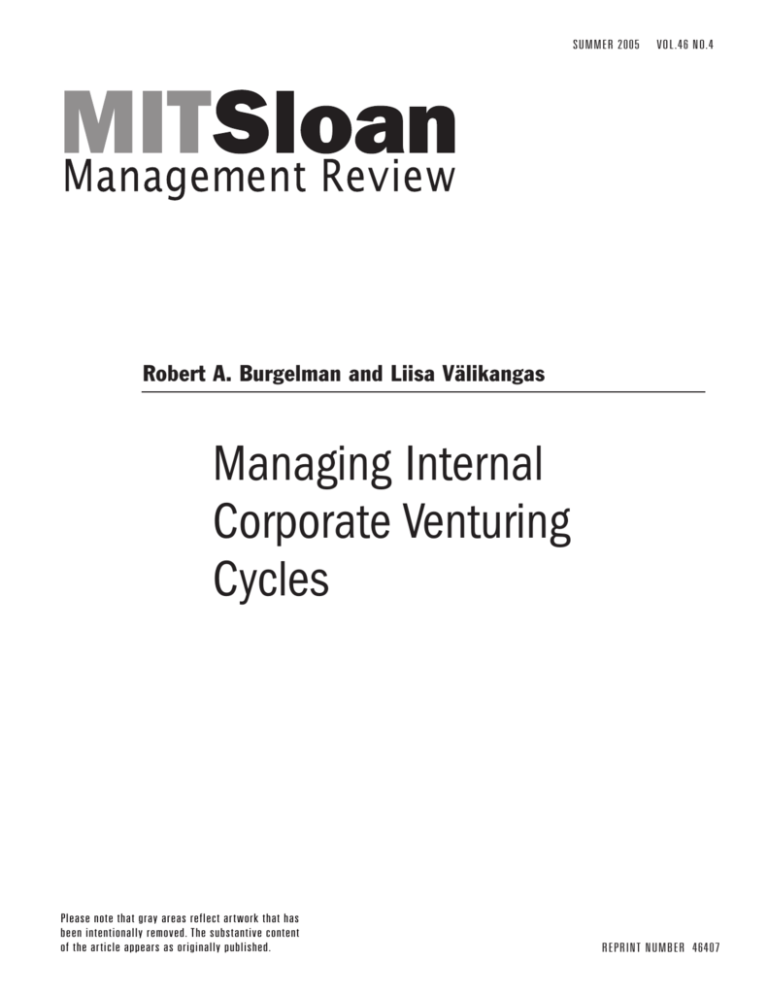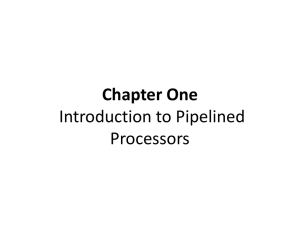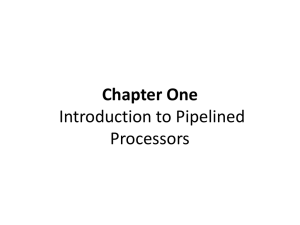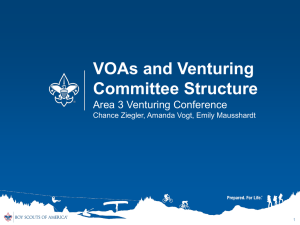
SUMMER 2005
VOL.46 NO.4
Robert A. Burgelman and Liisa Välikangas
Managing Internal
Corporate Venturing
Cycles
Please note that gray areas reflect artwork that has
been intentionally removed. The substantive content
of the article appears as originally published.
REPRINT NUMBER 46407
Managing Internal Corporate
Venturing Cycles
Companies too often
vacillate in their
T
commitment to internal
corporate venturing
activities, leading to less
than optimal outcomes.
Executives need to
better understand — and
manage — the factors that
drive cyclicality in internal
corporate venturing.
Robert A. Burgelman
and Liisa Välikangas
hirty years of systematic study of internal corporate venturing has revealed
that many major corporations experience a strange cyclicality in their ICV
activity. (See “About the Research,” p. 28.) Periods of intense ICV activity are
followed by periods when such programs are shut down, only to be followed
by new ICV initiatives a few years later. Like seasons, internal corporate venturing programs begin and end in a seemingly endless cycle.
Consider Lucent Technologies’ New Ventures Group, which was set up to reap commercial value from Bell Labs technology. In January 2000, the group was acclaimed as
exemplifying best practice for a new-ventures division.1 Yet Lucent, in the aftermath of
the telecom downturn, in 2002 sold 80% of its interest in the New Ventures Group to
Coller Capital, a British private-capital management company.
Other ICV programs have substantially changed their character or mission. In its
first three years of existence, Baxter International Inc.’s nontraditional-innovation program, for example, transformed its mission from the pursuit of new technologies in
new markets to the exploration of business opportunities closer to the core business.2
(A new CEO has recently revived a broader search for new growth areas.) A few years
ago, Shell GameChanger, the radical innovation program at Royal Dutch/Shell Group
of Companies, might have solicited ideas ranging from carpooling to waste reclamation
to sandwich sales to urbanites. However, in today’s innovation climate, such ideas are
too radical.3
Xerox Corp. offers still another example. After ad hoc efforts to manage its technology
ventures, Xerox established an innovation board in the 1980s to aid decision making. The
administrative board soon gave way in 1989 to an internal venture-capital group called
Xerox Technology Ventures, to invest in Xerox technologies that showed market potential
but were outside Xerox’s core business interests. XTV was terminated in the mid-1990s,
and yet another structure, called Xerox New Enterprise, became its replacement. XNE
took more aggressive ownership of the ventures yet sought to infuse them with entrepreneurship. XNE, in turn, was terminated in the late 1990s.4
These examples should not come as a surprise. Earlier research found that in many
companies, ICV programs manifest significant cyclicality.5 Chesbrough describes the
ICV cycle as follows: “The general pattern is a cycle that starts with enthusiasm, continues into implementation, then encounters significant difficulties, and ends with
eventual termination of the initiative. Yet within a few years, another generation of
businesses undertakes the effort anew, and the cycle occurs again.”6 This recurring pheRobert A. Burgelman is the Edmund W. Littlefield Professor of Management at Stanford University
Graduate School of Business, where he is also director of the Stanford Executive Program. Liisa
Välikangas is the managing director of the Woodside Institute and an adjunct professor at Helsinki
School of Economics. Contact the authors at burgelman_robert@gsb.stanford.edu and lvalikangas@
woodsideinstitute.org.
26
MIT SLOAN MANAGEMENT REVIEW
SUMMER 2005
selection that leaves very little room for new-business
experimentation. He and others basically advocate
giving up on what they call “new leg” venturing:
efforts to develop entirely new businesses for the corporation.8
The fact that ICV activities have persisted over
decades, however, suggests that the management
issues associated with ICV cyclicality are not likely to
go away.9 Historical evidence from the last three
decades suggests that the perceived importance of
ICV may fade away for a while, but ICV predictably
comes back with a vengeance and will likely continue
to be a nagging strategic leadership challenge for top
management.
Why Internal Corporate Venturing Cycles Persist
Early research efforts suggested that the interplay
between the prospects of a company’s mainstream
businesses and the availability of uncommitted financial resources created a strong force driving ICV cyclicality.10 There are four common situations that can
result from that interplay. (See “What Drives Internal
Corporate Venturing Cycles?” p. 29.)
nomenon seems wasteful of a company’s financial and human
resources. ICV programs are usually closed before investment
pays off, and careers are often damaged. Also, potentially
important learning from a previous program often does not
inform the next one.
Interestingly, as our recent examples indicate, ICV cyclicality
continues several decades after researchers first observed the
phenomenon. That suggests that companies have not yet
learned to use some of the research findings about ICV in their
strategic-management approaches. It also underscores the fact
that managing ICV is quite difficult. It is so difficult that one
scholar, Andrew Campbell, has argued in a recent debate in
European Business Forum against even trying to develop a
strategic leadership discipline for dealing with internal corporate venturing as a dynamic internal force.7 Instead, Campbell
recommends adopting a tight, top-driven approach to project
Situation 1: “ICV Orphans” If a company has uncommitted financial resources, it can afford to support
internal-venturing projects. If, however, the prospects
of the mainstream businesses are sufficient to meet
the company’s profitable growth objectives, there is
little motivation to support ICV actively, and top
management is more likely to pay lip service to it. A
number of entrepreneurial projects that nevertheless
have managed to get started in the nooks and crannies
of various business units are likely to drift along as
“orphan” projects. In this case, the ICV cycle has started, even
though top management is not actively managing it.
Situation 2: “All-Out ICV Drive” If the company has financial
resources available but the prospects of the mainstream business
are expected to be insufficient for meeting corporate objectives
for profitable growth, top management is motivated to support
ICV projects actively. In this situation, top management is likely
to form a new-venture division or new-business group. Such a
structural arrangement then becomes the home for all existing
ICV orphan projects and also serves as the implementation tool
for starting an ambitious top-driven ICV program.
Situation 3: “ICV Irrelevance” If there are few uncommitted
financial resources available, but the prospects of the mainstream businesses at the moment look sufficiently promising,
SUMMER 2005
MIT SLOAN MANAGEMENT REVIEW
27
top management is likely to consider ICV largely irrelevant. All
attention is to be focused on exploiting opportunities in the
core businesses.
Situation 4: “Desperately Seeking ICV” A lack of uncommitted
financial resources combined with a mainstream business with
inadequate growth prospects is likely to lead top managers to
latch on desperately to the first reasonable-looking ICV project
that comes their way. Given the limited choice of ICV projects
that executives face in this situation and the substantial uncertainty associated with any ICV project, the likelihood of failure
is high.
Forces Determining the Length of the ICV Cycle
To some extent, corporate venturing may follow the ups and
downs of the economy. When cash is readily available, corporations invest in new-venture programs; when cash becomes short,
the programs are terminated. However, the macroeconomic
explanation for ICV cyclicality is probably partial at best. Corpo-
About the Research
The foundation of this paper is a mix of field research conducted over a 30-year period, examples from our current
field research, analysis of other scholars’ research, and
examples derived from past and recent business press.
Burgelman has studied internal corporate venturing in a
number of companies in different industries since the mid1970s. His most recent research on ICV has been at Intel
Corp. in the context of a comprehensive study of the role of
strategy making in corporate evolution, and he is currently
collaborating with Monitor Ventures, part of the consulting
firm Monitor Group to develop a strategic-leadership discipline for sustained ICV management. Välikangas has worked
with a number of leading companies to develop their internal innovation capabilities in pursuit of strategic resilience,
and this paper draws on that work. In her work at the
Woodside Institute, she is currently exploring innovative
practices in core management processes such as strategic
planning and internal venturing.
rate strategic and administrative factors likely have greater bearing on the length of the venturing cycle.
Estimates of the length of the ICV cycle vary. Block and
MacMillan assess the cycle to be 10 years.11 Fast, however, notes
that the corporate venturing programs started by many Fortune
500 companies in the late 1960s and early 1970s were disbanded
during the late 1970s.12 Burgelman’s in-depth study of a newventure division in a large diversified company during the midto-late 1970s also found a somewhat shorter cycle.13
28
MIT SLOAN MANAGEMENT REVIEW
SUMMER 2005
Annual budgeting and three-year rolling budgets may contribute to the ICV cycle by establishing a one- to three-year
time horizon in which top management expectations must be
met or a venture program risks being deemed ineffective. This
timeline puts perverse pressures on ventures to “grow big fast”
and potentially leads to dysfunctional managerial behavior,
such as neglecting to develop the organizational infrastructure
of a venture in order to secure continued and timely new-product development.14
Biggadike has shown that, on average, it takes 10 to 12 years
before the return on investment for new ventures equals that of
mature businesses.15 That is much longer than the average time
fast-track executives are expected to stay in the same job in most
large companies. This creates at least three potential problems.
First, executives who do stay that long in a venture-manager position may be running severe career risks, especially if the venture
eventually is unsuccessful.16 Second, unless the company’s
human resources function has developed clear executive career
paths that require experience in venture positions and has
ensured that capable managers are available to take over from
those who are due to rotate out of a venture position, either some
executives will end up staying in the position too long or the venture program will experience disruptive management changes.17
A recent case study of a product innovation in a technology company, for example, showed that frequent changes in the executive
sponsor were detrimental to the commercial success of a disruptive innovation.18 Third, unless a process is in place to measure
managerial performance in new ventures in terms of clearly
established milestones, executives may engage in rational but
narrowly opportunistic behavior; they may focus on achieving
short-term results at the expense of building the necessary infrastructure for long-term venture development.19 They do so
because they anticipate that, given the normal rotation of executives to different positions, someone else will be in charge by the
time the innovation can be fully harvested.
Forces Driving the End of an ICV Cycle
The simplest driver for ending ICV programs is their failure to
deliver. But if corporate venturing programs are typically closed
before they have had a chance to prove themselves, other reasons than mere performance must be involved. Recent studies
of various forms of corporate venturing shed interesting new
light on the role of performance in ending an ICV cycle.20 In
particular, some ICV programs have been terminated despite
their apparent success. In general, these findings suggest that
both top management and the executives involved in the ICV
program fail to appreciate the role of ICV in a company’s corporate strategy.
One important case involves Xerox Technology Ventures in
the mid-1990s. This program is credited with too much success in
What Drives Internal Corporate Venturing Cycles?
Unless executives understand and manage the factors that cause
cyclicality in internal corporate venturing, a company’s ICV strategy
is apt to fluctuate over time, varying with the growth prospects of
the main business and the availability of uncommitted financial
resources.
Available
ICV
Orphans
All-Out
ICV Drive
ICV
Irrelevance
Desperately
Seeking ICV
Uncommitted
Resources
Unavailable
taken by the prior manager and may want to leave a mark
by making changes. In addition, ICV programs are usually
easy targets for incoming CEOs to end.
The combination of such administrative issues with a
general lack of understanding of the role of ICV programs
in long-term corporate-development strategy may lead to
what game theorists call “weakness of will.”24 Weakness of
will is about the inability to sustain commitment. Investing
in innovation is a long-term commitment and sometimes
involves difficult trade-offs with short-term pressures. As
Machiavelli observed, the benefits to the innovator are
uncertain, but the costs to those affected by the changes
involved are not.25 That is one reason resistance to innovation is likely to be stronger within an established organization than support for it.
Implications for Strategic Management of ICV
After a recent downsizing of corporate ventures, one CEO
lamented privately that the extent of the cuts had elimiSufficient
Insufficient
nated future growth options. As that lament illustrates, the
Prospects of the
Mainstream
bad news stemming from our analysis is that ICV cyclicalBusinesses
ity is a nagging strategic leadership challenge facing top
SOURCE: Adapted from R.A. Burgelman, “Corporate Entrepreneurship and Strategic Management:
management of established companies. The good news is
Insights From a Process Study,” Management Science 29, no. 12 (December 1983): 1349-1365,
and R.A. Burgelman, “Strategy Is Destiny: How Strategy-Making Shapes a Company’s Future”
that the cyclicality of ICV is primarily the result of execu(New York: Free Press, 2002).
tives failing to master the forces that cause fluctuations in
long-term support for ICV — a failure that can be remedied.
that “success might have made the [Xerox’s] internal units look
Too often, there is either too much or too little venturing
bad by comparison.”21 There was the added fear that such sucgoing on at any point in established corporations, and top mancess might have come at the expense of Xerox shareholders, as
agement allows support for ICV to oscillate among the four scethe startups funded by XTV may have competed for business
22
narios described earlier. ICV, however, is too important for a
with Xerox.
company’s long-term success to be dictated by fluctuating finanIn another case, a group of scientists at AT&T Corp. started a
cial fortunes, short-term strategic pressures, perverse administracampaign called Opportunity Discovery Department in 1995 and
tive routines or fickle management fads. Research shows that
sought to revitalize Bell Labs research and its links to the corpoachieving growth through diversifying acquisitions is fraught
rate strategy.23 ODD developed innovative strategies, worked
with expensive failure.26 Thus internal corporate venturing
with business units to think of future scenarios, networked with
many external experts, and ignited a grassroots movement of
remains a key capability for established companies seeking to
some 400 people. The ODD initiative came to an end, however,
achieve strategic renewal and avoid stalled growth.27 It is a stratein 1998 as the group was judged by standard performance metgic leadership imperative for top management to learn to better
rics to have failed to produce enough patents. A more important
manage the ICV cycle. Specifically, several important implicareason was that management found it difficult to accept that the
tions for the discipline of ICV strategic management emerge
group was taking credit for strategy making, something that was
from our analysis.28
considered a top-management responsibility and privilege.
Those who saw setting strategy as their prerogative perceived
There is always ICV going on, so manage it. There may not be a
ODD as a threat, and the group’s highly innovative approach only
dedicated internal-venturing unit in a company, yet it is likely
added to the discomfort.
that some employees are exploring new-business opportunities
Administrative factors can also end an ICV cycle. Companies
that are outside the scope of the corporate strategy at the time
often reorganize to meet changing environmental demands or to
that the initiatives originate. Internal-venturing activity may very
keep things fluid. An ICV program may create interference with
well be an irrepressible force in all established companies.29 Realthe new organizational structure. A newly appointed executive to
izing that ICV activity is actually hard to stamp out completely
the ICV program may not be committed to the course of action
may increase top management’s motivation to manage it better.
SUMMER 2005
MIT SLOAN MANAGEMENT REVIEW
29
Even when not needed to support profitable growth objectives, ICV activity can be an important
indicator of where the company’s employees think future opportunities lie.
However, without management encouragement, much of the
autonomous, employee-driven ICV activity will cease, either
because the employees involved grow frustrated by an eventual
lack of traction or because they leave the company to pursue the
opportunity in a startup. This is often the case in companies in
Situation 1, in which orphan ICV initiatives find it difficult to
get senior management support, and even sometimes in Situation 3, where the ICV initiatives that are likely to emerge are
considered irrelevant.
To better capitalize on the company’s natural source of ICV
activity, top management needs to put in place a process that
makes entrepreneurial employees comfortable coming forward
with their ideas and mobilizes senior management to begin
determining the new opportunities’ “strategic context,” a process
that involves evaluating innovations and championing promising
ones that the company can then embrace and fully support.30
Such a process needs to superimpose strategic discussions on top
of financial analyses such as net present value calculations, in
order to better ascertain what the potential impact of an innovation may be on the company’s future.
An old but striking example of the hazards of evaluating innovations by strictly financial measures is the emergence of electronic fuel injection.31 Today, Robert Bosch GmbH, based in
Stuttgart, Germany, is a leading supplier of electronic fuel-injection systems. However, Bendix, an American company, invented
electronic fuel injection. At Bendix, net present value calculations, together with anticipated near-term reactions from original equipment manufacturers in the United States, did not
suggest that electronic fuel injection would be an economically
viable new product. When Volkswagen AG decided to work with
Bosch to bring a mass-produced car with electronic fuel injection
to market during the late 1960s, Bendix opted to license its technology to Bosch. By the time Bendix realized that electronic fuel
injection would be a big opportunity and rushed to pursue it, it
was too late, given the time remaining on its patents, to establish
a position of market leadership.
By now, the concept of “disruptive technology” has begun to
raise top management’s awareness of the need to adopt a more
strategic approach to innovation.32 But the link between disruptive technology and ICV, which is often its source, remains
undermanaged. Eastman Kodak Co. is a case in point. One of
the great industrial and commercial success stories of the 20th
30
MIT SLOAN MANAGEMENT REVIEW
SUMMER 2005
century, Kodak had a somewhat checkered history in pursuing
ICV during the 1970s and 1980s.33 During the late 1990s, however, the company was still seeking to migrate from film — a
source of a “breathtaking” decline in earnings — to invest $3
billion in digital photography, a major disruptive force.34 Ironically, Kodak had been making investments in digital photography since 1972. However, by 2003, film still accounted for about
50% of Kodak’s profits.35
View ICV as a source of insights that can inform strategic
direction. Even when not needed to support profitable growth
objectives at a particular moment in time, ICV activity can be an
important indicator of where the company’s employees think
future opportunities lie. Indeed, self-organizing, emergent ICV
activity can be an important source of strategic foresight. Smart
top executives recognize that ICV is a discovery process that
should be evaluated first and foremost in terms of the information that it generates and not viewed only in terms of dollars
added to the revenue line.36 Rather than seeking to quash ICV or
direct it too heavily, top management should view it as a source
of strategic insight into the future. Senior executives should be
interested in the ideas and related autonomous strategic initiatives that entrepreneurial employees may be working on in their
spare time. Management should try to understand what is so
motivating and promising that people are willing to work on it,
often after regular working hours or on weekends. If a company’s employees are working on such innovations, competitors
and startups may also be. Companies can capitalize on grassroots innovation by their employees. For example, during the
last five years, Whirlpool Corp. has systematically tapped
employee ideas, ending up with a pipeline of product innovations including dishwashers for single-person households, ovens
that freeze and heat, and garage appliances for men.37
An “all-out ICV drive” biases the process and often engenders
costly mistakes. Such top-driven initiatives tend to warp the
ICV process because many employees then perceive the ICV
career route as the most attractive one simply because of management’s forcefully expressed interests. As a result, the mainstream business runs the risk of losing top talent, to the great
frustration and resentment of those still generating all of the
company’s profits. Intel Corp.’s all-out drive in the late 1990s to
by disruptive technologies, which the company may very well
have dabbled in early on but given up or failed to capitalize on.
To avoid ending up in this situation, it is imperative that top
management remains actively involved in a corporate ICV
strategy on a continuous basis even when the mainstream business is prospering. If top management waits until new business
opportunities are desperately needed, it is usually already very
late in the game.
develop new businesses, for example, had executives in the
microprocessor business complaining that they could not hold
on to key employees who wanted to join the more exciting new
ventures supported by top management. Top-driven ICV may
also result in big losses, because top management may prematurely invest significantly to try to fully exploit and accelerate
new growth opportunities. For example, by the time Iridium
LLC, a satellite-telephone service, filed for Chapter 11 bankruptcy in August 1999, Motorola Inc. had invested $3.5 billion
in the venture.
Building Leadership Capability to Manage the ICV Cycle
If ICV is desperately needed, it may be almost too late. When
desperately seeking ICV, a company is faced with the dire
prospect of a decaying core business. Such decay is often caused
How can companies develop the necessary strategic leadership
to avoid getting trapped in any of the four common situations
associated with the ICV cycle? To avoid the pitfalls of unmanaged cyclicality, ICV should be viewed as an integrated and con-
Lessons From Intel
Research on Intel Corp. illustrates factors
that drive ICV cyclicality and also illustrates that by recognizing the ongoing
strategic importance of ICV, companies
can mitigate some of the cyclicality.
Between 1987 and 1997, Intel essentially
operated in Situation 1 (ICV Orphans) as
its core microprocessors for the personal-computer market segment propelled it from about $3 billion in
revenue in 1988 to about $27 billion by
1997, accompanied by extraordinary
profitability. Toward the end of 1997,
however, the PC market segment seemed
to be slowing down significantly, which
put Intel in Situation 2 (All-Out ICV
Drive). Top management engaged in
something of a crash effort to turbocharge its new-business development
efforts, creating a New Business Group in
1998 to do so. Many orphan projects
were transferred to the NBG. At the same
time, top management initiated some
very large new ventures. In part hampered by the downturn of the economy
and the Internet bust, most of these ventures did not succeed.
Nevertheless, the emphasis on newbusiness development led Intel to
embrace more forcefully new initiatives
in the wireless-communications and networking-communications markets,
thereby significantly expanding the
scope of its corporate strategy. By 2001,
however, Intel top management faced
competing needs: continuing to invest in
new ventures, raising the investment
stakes in the core businesses to stay
ahead of the competition in technology
and manufacturing, and continuing to
nurture the money-losing but promising
new businesses in networking and wireless communications. Predictably, the
perceived relevance of ICV diminished
significantly, and the new business
group was scaled back. The ICV activity
was merged with Intel Capital, Intel’s
corporate venture-capital arm, in late
2002. Subsequently, Les Vadasz, president of Intel Capital, and John Miner,
vice president and general manager of
the New Business Group, were jointly
managing the merged group.
From this point on, Intel Capital’s
charter included not only external but
also internal investments in areas that
were potentially important for Intel’s
future businesses. The New Business
Group was renamed New Business Incubation Group and became a corporate
“greenhouse” where companies and
technologies that were too new to be
easily placed within Intel were nurtured
and protected from the demands of the
established groups. John Miner says
that “after reorganizing the New Business Group, we completely refocused
on activities that benefit from being
part of Intel. All our ventures build
products that can be done on a wafer.
We have activities in hand-held wireless, display and pixel-processing technologies, wireless and nonwireless
broadband, and photonic components.
We focus on the early technology-capture process to develop new business
applications and look for commercialization opportunities.”
Miner also says, “We always look for
two-way linkages with other parts of
Intel. Two business opportunities came
directly from the [company’s] Wireless
Computing and Communications Group;
they will go back there. On the other
hand, we also have two for which it is
not yet clear where they will go.” With
regard to NBI, Miner believes that “a key
challenge is how to maintain corporatelevel interest. We continuously try to
develop strategic value for the company, and we want to pay our own way
doing it. The biggest challenge is lateral, how to work with peers in other
parts of the company and look farther
out for strategic gaps they may need to
fill — without necessarily having agreement on the strategy. We think that
doing new businesses internally and
organically makes them easier to assimilate, and less costly. But sometimes we
do it in parallel, both through incubation and through small acquisitions.”
SUMMER 2005
MIT SLOAN MANAGEMENT REVIEW
31
UPM-Kymmene Corp., a leading Finland-based forest and paper-products company, has venturing
activities that both challenge and broaden the interpretation of corporate strategy.
tinuous part of the company’s strategy-making process, rather
than as an insurance policy whose appeal varies according to the
prospects of the company’s mainstream businesses. Effectively
integrating ICV into the strategy-making process requires recognition on the part of top management that internal corporate
venturing involves a distinct strategic leadership discipline — a
discovery process based on experimentation and selection38 —
that informs executives about emerging opportunities and facilitates nuanced adjustments to the company’s strategic direction.39 Treating ICV this way consistently over time is likely to
raise important questions that will help shape corporate strategy. For instance, which new opportunities consistent with the
core strengths of the company does ICV open up? Which new
leverage points in competition might ICV provide? How does
ICV inform us about the potentially unmet needs of our customers and new market segments? What does ICV tell us about
the blind spots in our current competitive strategy, especially in
relation to potentially disruptive technologies?
UPM-Kymmene Corp., a leading Finland-based forest and
paper-products company that is listed on the Helsinki and New
York stock exchanges, has experienced benefits from its venturing activities, in part because the activities both challenge and
broaden the interpretation of corporate strategy. UPM has a history of new business creation beyond paper, partly through one
of its predecessor companies, Yhtyneet Paperitehtaat. The company’s newest venture, UPM Rafsec, was founded in 1997 to
mass-produce radio-frequency identification tags for global
markets. Currently, through its New Ventures organization,
UPM is dedicated to exploring new areas in which the company
has materials and manufacturing know-how, such as printed
electronics, nanotechnology, smart labels and chemical indicators. But New Ventures also helps facilitate innovation more
broadly inside UPM’s core businesses. It has developed forums
for innovators across focal areas — called “clusters” — that represent core technologies and significant future opportunity for
existing UPM divisions. These clusters and their activities offer
vehicles for cross-divisional collaboration, bringing innovation
processes and tools that New Ventures has developed from the
venturing periphery to the core. For instance, New Ventures has
helped introduce product-development tools, such as prototyping, that make innovation less risky and more efficient. The
return on investment for UPM’s small 13-person New Ventures
32
MIT SLOAN MANAGEMENT REVIEW
SUMMER 2005
group is so far perceived to be high and exemplary.
When companies recognize the importance of ICV to strategy,
they are less likely to try to do away with ICV entirely. Intel’s decision in 2001 to scale back rather than end its efforts to develop
new ventures offers an example of a leading corporation attempting to better manage the ICV cycle. (See “Lessons From Intel,” p.
31.) Intel is persisting as the company tries to make its commitment to venturing pay off in the long run.40
Taking control of the ICV cycle allows executives to rationalize resource allocation. This will reduce the tendency to flood
ICV with resources in good times, which takes away entrepreneurial hunger, and to starve it in bad times, which aborts potential successes. Rationalizing resource allocation implies careful
early experimenting with small amounts of resources to gain
insight into radically new opportunities that inherently involve
high technological and market uncertainties. It also implies consistent nurturing of new businesses that pass strategic and financial milestone reviews, with carefully calibrated resource
commitments increasing over extended periods.41 It is important
to maintain some predictability in resource allocation so that,
once milestones have been met, further funding will result independently of the business cycle.
Another key aspect of managing internal corporate venturing
cyclicality is making ICV a responsibility of all senior executives.
If senior executives in the mainstream businesses do not feel that
they share responsibility for ICV, do not feel that ICV efforts are
central and lasting, or do not feel that the executives running ICV
are equally able peers, the forces driving ICV cyclicality are likely
to prevail. In order to make a new venture a corporate success,
executives involved in ICV need to be able to sponsor and guide
the new venture and to start the process of determining its strategic context within the corporation. Determining a new venture’s
strategic context involves working diligently to explore its links to
the corporate strategy and to persuade top management to make
the venture part of the corporate business portfolio. But that
process depends on getting support from at least some of the senior executives from the mainstream businesses, so that top management can be assured that the rest of the organization will
embrace the new venture. As a result, a climate of mutual respect
on the part of all the senior executives involved is critical. Intel
achieved this by assigning highly respected senior executives to
head up its ventures organization. Nokia Corp., too, achieved
this, in part through the development of a ventures board of
directors on which all the senior executives serve. And, equally
importantly, the president of Nokia was put in charge of all the
company’s corporate venturing efforts.42
ICV cyclicality is probably here to stay because of the powerful forces that create it. Learning to better manage the ICV
cycle, however, is important for large, established companies
because other profitable growth avenues may not be promising.
Major, portfolio-diversifying acquisitions are costly and often
do not create shareholder value. Smaller and midsize acquisitions can play an important role, but eventually smallish acquisitions may not remain sufficient to reach corporate growth
objectives. Developing an effective ICV capability thus seems an
unavoidable strategic imperative for top management of large
companies.43 We should perhaps not be surprised that few companies have been successful in developing such a capability
because the strategic leadership skills that are required to effectively explore and develop ill-defined and uncertain new-venture opportunities are different from those required to exploit
well-defined and incremental core-business opportunities. Our
analysis suggests, however, that top management can learn to
better manage the forces that drive ICV cyclicality — and avoid
being driven by them.
ACKNOWLEDGMENTS
The authors thank Julian Birkinshaw of the London Business School
and Bill McKelvey of the University of California, Los Angeles, for helpful comments and queries.
REFERENCES
1. Corporate Strategy Board, Executive Inquiry, “The New Venture
Division, Attributes of an Effective New Business Incubation Structure”
(January 2000): 14.
2. A. Hunt, vice president of innovation, Baxter International Inc., interview with L. Välikangas, fall 2004.
3. L. Välikangas, “Shell GameChanger: Mastering the Corporate Innovation Game,” working paper, Woodside Institute, Woodside, California, 2004.
4. H. Chesbrough, “Graceful Exits and Missed Opportunities: Xerox
Management of its Technology Spin-off Organizations,” Business History Review 76, no. 4 (2002): 803-837.
5. The literature on ICV is broad if somewhat fragmented, reflecting
sustained interest on the part of scholars and practitioners over many
decades. It is true that the phenomenon of ICV cyclicality has been “in
the air” for a long time. See, for example, N.D. Fast, “The Rise and Fall
of Corporate New Venture Divisions” (Ann Arbor, Michigan: UMI
Research Press, 1978); R.A. Burgelman, “Corporate Entrepreneurship
and Strategic Management: Insights From a Process Study,” Management Science 29, issue 12 (December 1983): 1349-1365; R.A. Burgelman, “Managing the New Venture Division: Research Findings and
Implications for Strategic Management,” Strategic Management Journal 6, no. 1 (March 1985): 39-55. However, it has seldom been the
main focus of attention in the ICV literature, and there has been little
systematic discussion of what generates the start, duration and ending
of the ICV cycle. For a fairly recent textbook-style overview of the
broad ICV literature, see M. Morris and D. Kuratko, “Corporate Entrepreneurship: Entrepreneurial Development Within Organizations” (Fort
Worth: Harcourt College Publishers, 2002). For a recent anthology of
various entrepreneurship-related perspectives, see M.A. Hitt, R.D. Ireland, S.M. Camp and D.L. Sexton, eds., “Strategic Entrepreneurship:
Creating a New Mindset” (Oxford: Blackwell Publishers, 2002).
6. H. Chesbrough, “Designing Corporate Ventures in the Shadow of
Private Venture Capital,” California Management Review 42, no. 3
(2000): 31-49.
7. A. Campbell and R.A. Burgelman, “EBF Debate: Should Companies
Be Cautious Entrepreneurs … or Should They Embrace a Dynamic
Force?” European Business Forum, no. 15 (fall 2003): 12-15; and A.
Campbell and R.A. Burgelman, “EBF Debate: ‘Wait and Watch’ versus
‘Practice and Get Luckier,’ European Business Forum, no. 16 (winter
2003-2004): 36-39. For an effort to integrate Campbell’s and Burgelman’s perspectives in the debate, see R.M. Kanter “Exploring the
Innovation Pyramid,” European Business Forum, no. 16 (winter 20032004): 40-42. For a complete statement of Campbell’s position, see A.
Campbell and R. Park, “The Growth Gamble” (London: Nicholas
Brealey, 2005).
8. See also A. Campbell, J. Birkinshaw, A. Morrison, R. van Basten
Batenburg, “The Future of Corporate Venturing,” MIT Sloan Management Review 45, no. 1 (fall 2003): 30-37. For another view advocating
a limited role for ICV, see C. Zook with J. Allen, “Profit From the Core:
Growth Strategy in an Era of Turbulence” (Boston: Harvard Business
School Press, 2001).
9. Such persistence may be attributed partly to internal entrepreneurship being a dynamic force that is an important motivator at work. Corporate venturing offers many employees a chance to follow their
interests and passion, often in addition to their regular tasks. D.
Duarte and N. Snyder, in “Strategic Innovation: Embedding Innovation
as a Core Competency in Your Organization” (New York: Jossey-Bass,
2003), describe how Whirlpool Corp. was able to tap the ideas and
passions of many of its employees by making innovation a corporatewide privilege and capability.
10. Burgelman, “Corporate Entrepreneurship and Strategic Management,” 1349-1365.
11. Z. Block and I.C. MacMillan, “Corporate Venturing: Creating New
Businesses Within the Firm” (Boston: Harvard Business School Press,
1993).
12. Fast, “The Rise and Fall of Corporate New Venture Divisions.” For
more recent commentary on the short life spans of new venture divisions, see D.A. Garvin, “A Note on Corporate Venturing and New
Business Creation,” research note, Harvard Business School Press
(March 2001): 1-21.
13. R.A. Burgelman, “Managing Innovating Systems: A Study of the
Process of Internal Corporate Venturing” (Ph.D. diss., Columbia University, 1980).
14. R.A. Burgelman, “A Process Model of Internal Corporate Venturing
in the Diversified Major Firm,” Administrative Science Quarterly 28, no.
2 (June 1983): 223-245. See also R.A. Burgelman and L.R. Sayles,
“Inside Corporate Innovation: Strategy, Structure and Managerial
Skills” (New York: Free Press, 1986).
15. R. Biggadike, “The Risky Business of Corporate Diversification,”
Harvard Business Review 56 (May-June 1979): 103-111.
16. See, for example, F.J. Aguilar, “Bard Medsystems Division:
Intrapreneurial Showcase,” Harvard Business School case no. 1-387183 (Boston: Harvard Business School Publishing, 1987), which narrates the career hazards of an entrepreneurial division manager who
stays more than eight years in a struggling new venture.
17. Burgelman, “Managing Innovating Systems.”
SUMMER 2005
MIT SLOAN MANAGEMENT REVIEW
33
18. J. Moldenhauer-Salazar and L. Välikangas, “Radical Innovation
Through the Looking Glass” (presentation at Strategic Management
Annual Conference, Baltimore, Nov. 9-12, 2003).
19. Burgelman, “A Process Model of Internal Corporate Venturing in
the Diversified Major Firm.” For similar behavior in the strategic capital-investment process, see J. Bower, “Managing the Resource Allocation Process” (Boston: Harvard Business School Press, 1970). For a
more theoretical examination of opportunistic behavior, see, for
instance, O.E. Williamson, “Markets and Hierarchies: Analysis and
Antitrust Implications” (New York: Free Press, 1975).
20. P. Gompers and J. Lerner, “The Determinants of Corporate Venture Capital Success: Organizational Structure, Incentives and Complementarities,” chap. 1.1 in “Concentrated Corporate Ownership,” ed.
R. Morck (Chicago: University of Chicago Press, 2000).
Firm,” 237-238, and R.A. Burgelman, “Managing the Internal Corporate Venturing Process,” Sloan Management Review 25, no. 2 (winter
1984): 33-48. Strategic context determination critically depends on
“organizational championing” by executives. This is the most difficult
and least understood part of the ICV process, and the part that is most
likely to break down.
31. M.E. Porter and S.J. Roth, “Bendix Corporation,” Harvard Business School case no. 9-387-257 (Boston: Harvard Business School
Publishing, 1985).
32. C.M. Christensen, “The Innovator’s Dilemma” (Cambridge: Harvard Business School Press, 1997).
33. See N. Nohria, “Internal Corporate Venturing at Eastman Kodak: A
New Chapter in the Rise and Fall of the New Venture Division,” working paper, Harvard Business School, Boston, 1992.
21. H. Chesbrough, “Making Sense of Corporate Venture Capital,”
Harvard Business Review 80, no. 3 (March 2002): 90-99.
34. “Kodak Cuts Dividend by 72% to Finance Digital Transition,” Wall
Street Journal, Sept. 26, 2003.
22. Chesbrough, “Graceful Exits and Missed Opportunities,” 803-837.
35. “Kodak Aims to Become a Model of Reinvention,” Financial Times,
Sept. 27, 2003.
23. A. Muller and L. Välikangas, “An ODD Reaction to Strategy Failure
in America’s Once Largest Telco,” European Management Journal 21,
no. 1 (2003): 109-118.
24. S. Postrel and R.P. Rumelt, “Incentives, Routines and Self-Command,” Industrial and Corporate Change 1, no. 3 (1992): 397-425.
25. N. Machiavelli, “The Prince” (London: Penguin Books, reissued
2003).
26. See, for example, M. Hayward and D.C. Hambrick, “Explaining the
Premium Paid for Large Acquisitions: Evidence of CEO Hubris,”
Administrative Science Quarterly 42, no. 1 (1997): 103-129; and M.E.
Porter, “From Competitive Advantage to Corporate Strategy,” Harvard
Business Review 65, no. 3 (May-June 1987): 43-59.
27. J. Mackey and L. Välikangas, “The Myth of Unbounded Growth,”
MIT Sloan Management Review 45, no. 2 (winter 2004): 89-92.
28. Burgelman has presented evidence that exploring and exploiting
new-business opportunities outside the scope of the corporate strategy requires a different leadership discipline than the discipline
necessary to exploit existing opportunities, but requires a discipline
nevertheless. See R.A. Burgelman, “Strategy Is Destiny: How Strategy-Making Shapes a Company’s Future” (New York: Free Press,
2002). See also R.A. Burgelman, “Strategy as Vector and the Inertia
of Coevolutionary Lock-in,” Administrative Science Quarterly 47, no.
2 (2002): 325-357.
29. For a discussion of ICV initiatives as a natural dynamic force in
organizations, see R.A. Burgelman, “Corporate Entrepreneurship and
Strategic Management,” and R.A. Burgelman, “EBF Debate: Must We
All Be Entrepreneurs Now?” European Business Forum 15 (fall 2003):
13-15. Van de Ven and Garud, who found evidence that internal entrepreneurs tend to persist in their behavior under conditions of ambiguity
and slack despite negative feedback, provide some evidence for the
irrepressible entrepreneurial spirit. See A. Van de Ven and R. Garud,
“An Empirical Evaluation of the Internal Corporate Venturing Process,”
Strategic Management Journal 13, no. 8 (summer 2002): 93-110. Alva
Taylor found that initiators of new products outside the scope of the
existing corporate strategy did so in part because they anticipated that
if their initiative was not embraced by the company, they would be
able to find a new job related to their initiative in another company in
the industry. See A.H. Taylor, “A Process Study of the Influence of
Competition Between New Product Initiatives on Innovation and Organizational Learning” (Ph.D. diss., Stanford University, 2000).
30. “Strategic context determination refers to the political process
through which middle-level managers attempt to convince top management that the current concept of strategy needs to be changed so
as to accommodate successful new ventures.” See Burgelman, “A
Process Model of Internal Corporate Venturing in the Diversified Major
34
MIT SLOAN MANAGEMENT REVIEW
SUMMER 2005
36. Burgelman and Sayles, “Inside Corporate Innovation.” This insight
suggests the need for caution in too quickly adopting the distinction
made by Campbell and others between “new leg venturing” and “innovation venturing.” If ICV is indeed a discovery process, it may be clear
only after the fact whether some initiative was important for the core
business or truly a diversifying activity.
37. N. Snyder and D. Duarte, “Strategic Innovation” (New York:
Jossey-Bass, 2003).
38. Burgelman, “Corporate Entrepreneurship and Strategic Management” and Burgelman, “Strategy Is Destiny.” McGrath and MacMillan
provide a practical tool for planning for a new venture that takes into
account how the process differs from planning for mainstream businesses. See R.G. McGrath and I.C. MacMillan, “Discovery-Driven
Planning,” Harvard Business Review 73, no. 4 (July-August 1995): 4453.
39. G. Hamel and C.K. Prahalad, “Competing for the Future” (Boston:
Harvard Business School Press, 1994).
40. R.A. Burgelman and P. Meza, “Intel Beyond 2003: Looking for Its
Third Act,” Stanford Business School case SM-106 (Stanford: Stanford
Business School, 2003).
41. This is an area where the advice of Campbell and Harris to exert
caution in supporting ICV is valuable. While we strongly argue for continued support of ICV efforts, we also argue for a more deliberate and
controlled resource-allocation management to help dampen ICV cyclicality. See A. Campbell and R. Harris, “The Growth Gamble.”
42. Pekka Ala-Pietilä, president of Nokia Corp., communication with
R.A. Burgelman, fall 2000.
43. In fact, new ventures pursued in the ICV mode often need to be
augmented with relatively small to midsize acquisitions in order to
scale up within a limited time horizon to a size that makes the venture
relevant from the corporate point of view. But such “strategic building”
activities will benefit from already having some business initiative
going that offers insight into what might be the right acquisition in the
first place. In that sense, ICV can potentially play an important role in
a more broadly conceived idea of the “absorptive capacity” of the corporation. On strategic building, see Burgelman, “Managing the Internal
Corporate Venturing Process,” 33-49. On absorptive capacity, see
W.M. Cohen and D.A. Levinthal, “Absorptive Capacity: A New Perspective on Learning and Innovation,” Administrative Science Quarterly 35, no. 1 (March 1990): 128-134.
Reprint 46407. For ordering information, see page 1.
Copyright © Massachusetts Institute of Technology, 2005. All rights reserved.
PDFs ■ Reprints ■ Permission to Copy ■ Back Issues
Electronic copies of MIT Sloan Management Review
articles as well as traditional reprints and back issues can
be purchased on our Web site: www.sloanreview.mit.edu
or you may order through our Business Service Center
(9 a.m.-5 p.m. ET) at the phone numbers listed below.
To reproduce or transmit one or more MIT Sloan
Management Review articles by electronic or mechanical
means (including photocopying or archiving in any
information storage or retrieval system) requires written
permission. To request permission, use our Web site
(www.sloanreview.mit.edu), call or e-mail:
Toll-free in U.S. and Canada: 877-727-7170
International: 617-253-7170
e-mail: smrpermissions@mit.edu
To request a free copy of our article catalog,
please contact:
MIT Sloan Management Review
77 Massachusetts Ave., E60-100
Cambridge, MA 02139-4307
Toll-free in U.S. and Canada: 877-727-7170
International: 617-253-7170
Fax: 617-258-9739
e-mail: smr-orders@mit.edu
Reproduced with permission of the copyright owner. Further reproduction prohibited without permission.









